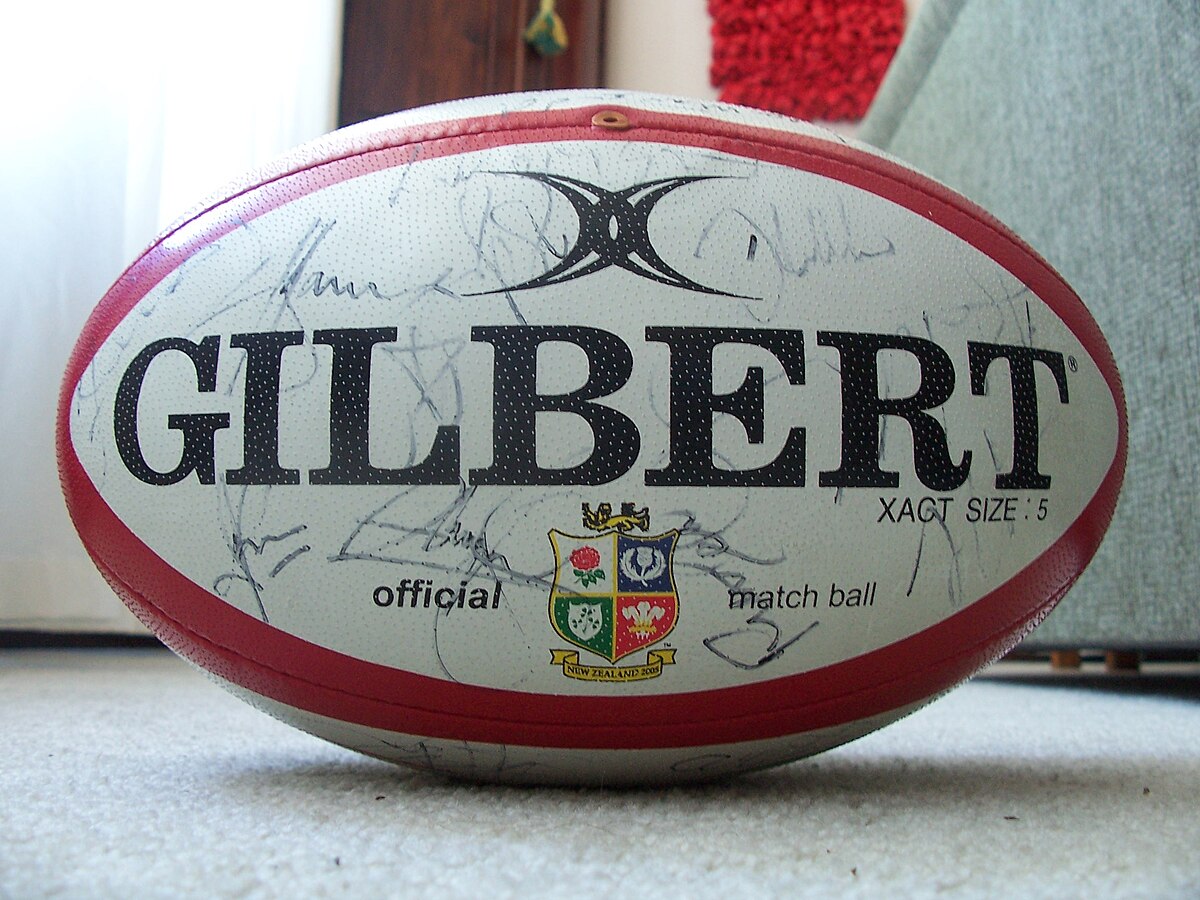A rugby ball is an oval-shaped ball used in the game of rugby. It is designed for easier passing and control during play.
Rugby is a sport that captivates fans with its blend of strength, strategy, and speed, and at the heart of the action is the rugby ball, the central piece of equipment. Made of leather or synthetic material, its distinctive shape sets it apart from balls used in other sports, offering a unique challenge to players.
The design primarily affects how the ball moves through the air and subsequently influences the game’s balance. Due to its large size and dimpled surface, the item guarantees a good grip, which is critical for the precision required in a high-energy game like rugby. Whether used for a match or training, the quality and condition of a rugby ball can significantly impact the flow and enjoyment of the game.
🔴Rugby Ball🔴

Table of Contents
History Of The Rugby Ball
The ‘History of the Rugby Ball’ takes us back to the beginnings of this sport. Over time, the ball’s shape, construction, and materials have evolved. Follow this historical journey to understand the rugby ball’s development and its unique role in the sport.
Introduction Of The Rugby Ball
Rugby began with a simple idea. A ball needed handling and kicking. Early rugby balls were plum-shaped. They came from pigs’ bladders. After inflation, they got a leather casing. By the late 1800s, oval balls were in play. Richard Lindon revolutionized their design. His rubber inner tubes meant safer and more uniform balls.
Rugby Ball Games
- Early rugby was quite varied. Different schools had different rules.
- The ball played a crucial part. Its size and shape changed gameplay.
- Today, rugby balls are central to rugby ball games everywhere. They must meet strict size and weight specifications.
Rugby Ball Vs Football
| Feature | Rugby Ball | Football (Soccer Ball) |
|---|---|---|
| Shape | Oval | Spherical |
| Size | Larger and longer | Smaller and rounder |
| Design | For carrying and kicking | Primarily for kicking |
The rugby ball and football differ significantly. The rugby ball’s unique shape suits its specific gameplay. In contrast, football is a foot-based sport. The rugby-ball football comparison shows how design can influence a sport.

Key Characteristics Of A Rugby Ball
Rugby, a sport known for its physicality and strategy, relies on one key piece of equipment: the rugby ball. The ball itself is unique compared to other sports. Let’s delve into the specific characteristics that define a rugby ball.
Shape And Size Of A Rugby Ball
The unique shape of a rugby ball sets it apart and impacts how the game is played.
- Elliptical shape for easy gripping and aerodynamics.
- Dimensions of a rugby ball size 5, which is the professional standard, include a length of 280–300mm and a circumference of 740–770mm width-wise.
- created for players with strong hands to hold and pass efficiently.
Materials Used In Making A Rugby Ball
Materials greatly impact the rugby ball’s performance during a game.
| Material | Characteristics | Benefits |
|---|---|---|
| Synthetic Compounds | Durable and water-resistant | Use in all weather conditions |
| Rubber Bladder | Maintains shape and air retention | Consistent performance |
| Outer Surface Grip | Dimpled or textured | Improved hand traction |
Initially, rugby balls were made from pig bladders and leather. Today’s rugby balls use advanced materials for optimal play.
Manufacturing Process Of A Rugby Ball
Rugby balls are essential for a game that combines strength, speed, and strategy. Crafting a rugby ball involves precision and care. Skilled workers turn raw materials into the central piece of a thrilling match. Let’s explore this fascinating journey.
Selection Of Materials
The first step is choosing the right materials. High-quality rugby balls are often made from synthetic materials. These materials are durable and provide a better grip. Manufacturers select material based on the ball’s intended use. They often use different materials for professional games and for practice.
Cutting And Shaping The Panels
Once materials are picked, they’re cut into panels. The ball’s shape comes from the way these panels are cut. A template ensures each panel is the right size and shape. The number of panels can vary. Most panels are oval or hexagonal.
Stitching And Assembling The Ball
Next, the panels are stitched together. This is a critical part of the process. Good stitching gives a ball its strength. Workers use special machines or hand-stitch the balls. They add a bladder inside the ball. The bladder holds air and gives the ball its bounce.
Inflation And Testing
The final steps are inflation and testing. The ball is inflated to the right pressure. Testing ensures it meets strict size and shape standards. Balls are often kicked and thrown to test their durability. Only balls that pass these tests go-to players.
The Role Of The Rugby Ball In Gameplay
The core of any rugby match is its uniquely shaped ball. This oval companion dictates the pace of play, influencing crucial plays and strategies. Let’s dive into how the rugby ball impacts gameplay at every level.
Passing And Catching
Passing is the heartbeat of rugby tactics. The rugby ball, often called by its rugby ball name, becomes a team’s lifeline as they move it across the field. Players master the art of spiraling the ball, achieving accuracy and distance. Smooth, quick passing can dismantle even the tightest defenses.
- Spiral passes reduce air resistance
- Quick hands are essential for effective gameplay
- Accurate catching ensures the momentum continues
Kicking And Punting
Kicking turns the rugby ball into a strategic weapon. Players apply various kicking techniques to gain territory or score points. A well-placed punt can change the game’s pace, while drop-kicks add thrilling field goals.
- Field position can shift with a single kick
- Drop-kicks score points during open play
- Kickers must account for ball shape and wind
Ball Handling And Carrying
Carrying the ball is a test of skill and strength. Players run, dodge, and fend off tackles while protecting the rugby ball. Secure handling prevents turnovers, keeping the attacking phase on track. Good carry positions are set up for successful passes or kicks.
- Hold the ball in two hands to pass quickly
- Use a strong grip to prevent drops
- Keep the ball away from defenders
Rugby Ball World Cup
During the Rugby Ball World Cup, the ball is not just a piece of equipment; it’s a symbol of pride and competitiveness. The world watches when the best players manipulate the ball, showcasing their skills on the grandest stage. Every pass, kick, and carry is amplified, with the cup’s unique ball design often becoming iconic.
Maintenance And Care Of A Rugby Ball
A rugby ball is the heart of the game, shaping every pass, kick, and try. Proper maintenance extends the lifespan as well as ensures peak performance during play. Below are essential tips to keep your rugby ball in top condition.
Cleaning And Washing
Keeping a rugby ball clean guarantees a good grip and better game control. To clean it:
- Wipe with a damp cloth.
- Avoid harsh chemicals and abrasives.
- Use a mild soap for tough stains.
- Dry naturally, away from direct heat.
Inflation And Pressure
Correct inflation is crucial for a rugby ball’s shape and bounce. Follow these steps:
- Use a pressure gauge to check the ball’s PSI.
- Inflate to the recommended pressure, often 9–10 PSI.
- Regularly check and adjust the pressure before games.
Storage And Protection
How and where a rugby ball is stored affects its lifespan. Remember to:
- Store it in a cool, dry place.
- Keep away from sharp objects.
- Avoid heavy weights on top of the ball to maintain shape.
Rugby Ball Price
The price of a rugby ball varies based on size, quality, and brand. To get value for money:
| Ball Type | Price Range |
|---|---|
| Training Balls | $15 – $30 |
| Match Balls | $30 – $100 |
| Professional Balls | $100 – $150 |

🔴Rugby Ball🔴
Frequently Asked Questions on Rugby Ball
What is the ball in rugby called?
The ball used in rugby is called a rugby ball. It’s oval-shaped and designed for easier gripping and carrying during the game.
Are rugby balls and American footballs the same?
Rugby balls and American footballs are not the same. Rugby balls are rounder and larger, while American footballs have a more pointed shape and are smaller for passing.
What is a rugby ball eye called?
A rugby ball eye is commonly known as a black eye or periorbital hematoma.
Why do they spin the ball in rugby?
Players spin the ball in rugby to improve accuracy and distance in passing. The spin stabilizes the ball mid-air, ensuring a more predictable flight path.
Conclusion
As we wrap up our exploration of the rugby ball, it’s clear that its design significantly impacts the game. Whether you’re an avid player or a fan, understanding the ball’s makeup enhances your appreciation of the sport. Remember, choosing the right rugby ball elevates play, so pick yours wisely and enjoy the dynamic game of rugby to its fullest.
 Cric Enjoy Sports News, Cricket Update, Live Streaming
Cric Enjoy Sports News, Cricket Update, Live Streaming






